Research says that on average, recruiters look at CVs for up to 6 seconds - at most!
That sounds a little harsh, right?
You spend days, weeks even, crafting THE picture-perfect CV that represents you in a nutshell - with bells and whistles and all.
And what does the recruiter do?
They glance it over for a few seconds (again, if lucky), and move on.
It might sound unfair, exactly how are you supposed to capture someone’s attention in a matter of seconds?
Well, we have an answer.
Are you ready?
It’s long and might be a little time-consuming. And no, there are no shortcuts.
If you want to perfect your CV, you might have to grease up your elbows, get your reading glasses, and make sure every little detail is polished to perfection. Once you do that though, believe us - it’s going to be worth it.
After all, that’s a small price to pay for landing the dream job you’ll be looking forward to.
By building a near-perfect CV, you’re essentially investing in yourself, and your future.
How do you do that?
- Do you need a CV or a Resume - & What’s the Difference?
- Use the right CV builder
- Pick the right CV format
- Get the CV layout right
- Add your contact information (the right way)
- Grab the HR manager’s attention with a CV summary or objective
- Show off your work experience (and stand out)
- Include relevant skills within your CV
- Include education within your CV
- Include other sections
- Top 3 CV examples
- Next steps in your job search - cover letter & interview
- Key takeaways
Let’s take it one step at a time.
Do You Need a CV or a Resume - What’s The Difference?
You might have noticed that when you’re applying for a job, some say to send your CV, while others prefer your resume.
So, what’s the deal? Aren’t they technically the same thing?
The answer: it depends on where you’re from.
In all of Europe - they are indeed the same thing and can be used interchangeably. If you’re applying for a job that asks for a CV, you should know that it’s the same as a resume.
Now, if you’re from the United States, it’s a bit different.
A resume is a one-page summary of your work experience and background to the job you’re applying to.
A CV, meanwhile, is a longer academic diary that includes all your experience, publications and more.
The main difference is that a resume is about one page (max. two), whereas the CV can be longer. A resume is used for job hunting in all industries, and the CV is used for jobs and admissions in academia. And finally, the resume is tailored to the specific job you’re applying to, and the CV is a comprehensive overview.
So, in short, CV vs. Resume - what’s the difference?
If you’re from Europe - they’re basically the same thing.
If not, a resume is a one-page summary of your work experience and background. And your CV is a longer academic diary that includes all your experience, certificates, and publications.
Simple, right?
Since you’re reading this guide, you probably want to learn how to make a regular, job-search CV. If that’s the case, then you’ve come to the right place.
For this, we recommend going with one of Novoresume’s CV templates.
What, you didn’t think you’d get away with using a simple text editor CV template, did you?
Nope, to stand out with your CV, you need something much more powerful.
Why Use a CV Builder
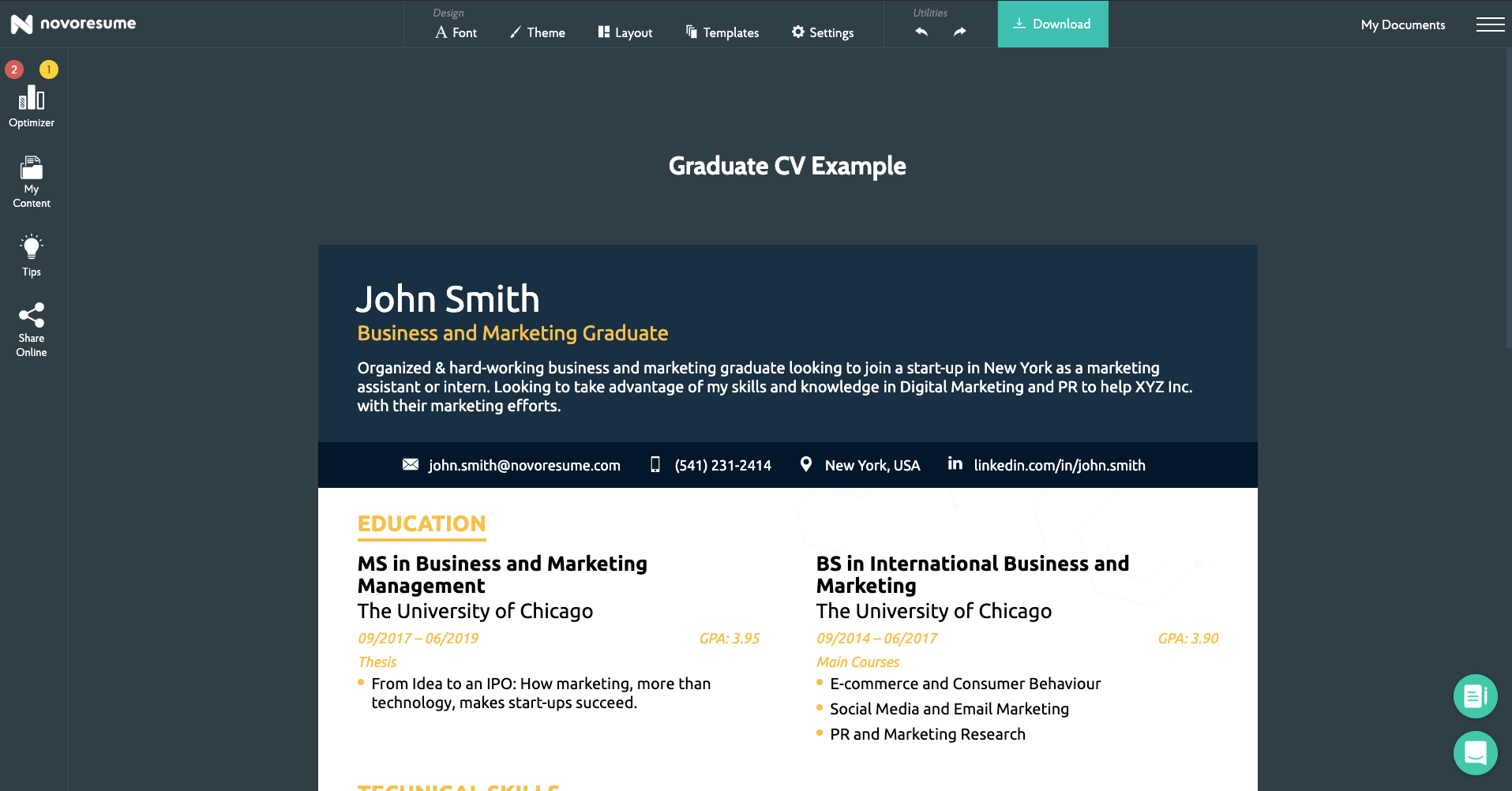
Most people use the default Word templates to create their CVs. The problem with that is that these default templates are often bland and lifeless. You want your CV to stand out, not fit right in with the rest of them.
Your average CV template is also a total pain to work with. Imagine this scenario...
You spend 2+ hours aimlessly trying to make your resume contents fit within the default template layout. And then, when you make one more tiny tweak, the whole thing gets completely messed up.
You start looking for a better CV template online and find one that costs $19.99 or more.
You painfully fork out the money and hope that this CV template is better than the ones you’ve tried so far.
Here’s a spoiler: it’s probably not. Word is for writing an essay in university, not for creating a resume.
Looking for a significantly easier experience?
Novoresume’s CV builder helps you build a 1 page CV for free (with a premium version if you’re looking for the extra push). It comes with plenty of customization, so, even though you work a template, you get to personalize it to your heart's content..
And the icing on the cake?
All of our CV templates are optimized for Applicant Tracking Systems (ATS).
What does this mean in normal terms, you ask?
Well, it simply means that the CV screening software that the HR manager is using will be able to read your CV for sure, giving you a much better chance to get past the screening process.
How to Format Your CV
Alright, let’s get down to brass tacks. So, what goes into a CV, exactly?
Now, there is no golden rule and not every CV has the same sections. A lot depends on your experience, and where you’re applying to. Though, some parts do stay the same.
- Contact information
- CV Summary or objective
- Work experience
- Skills
- Education
- Certifications and awards
- Languages
- Personal projects
- Volunteer Experience
We’re going to cover all of those sections step-by-step. Before we do that, though, let’s discuss how to...
Get The CV Layout Right
The first thing a job recruiter notices about any CV is the layout.
Things like:
- Is everything easy to find in one glance?
- Are the colors, fonts, and headings consistent?
- Is all the information well-organized?
Here are some of the best practices when it comes to getting your CV layout right:
- Keep it one page in length - You should only go for 2 pages if you’re confident you can’t summarize yourself in 1 page. Don’t waste your precious CV real estate on your life story - no one’s going to read it!
- Clear and consistent section heading - Keep the colors, font size, headings consistent so that it’s easy on the eyes. We’d recommend using a font that stands out, but not too much. Do use: Ubuntu, Roboto, Overpass, etc. Don’t use: comic sense.
- White-space - Make sure there are enough margins and space between the text so that the whole thing is easy on the eyes.
- Keep the details clear - pick the right font size (14-16pt for section titles, 11-12pt for normal text).
- Finally, save your resume as PDF, as Word might change up your CV formatting.
One last thing you might want to think about is whether your CV is going to be the traditional type or the creative one.
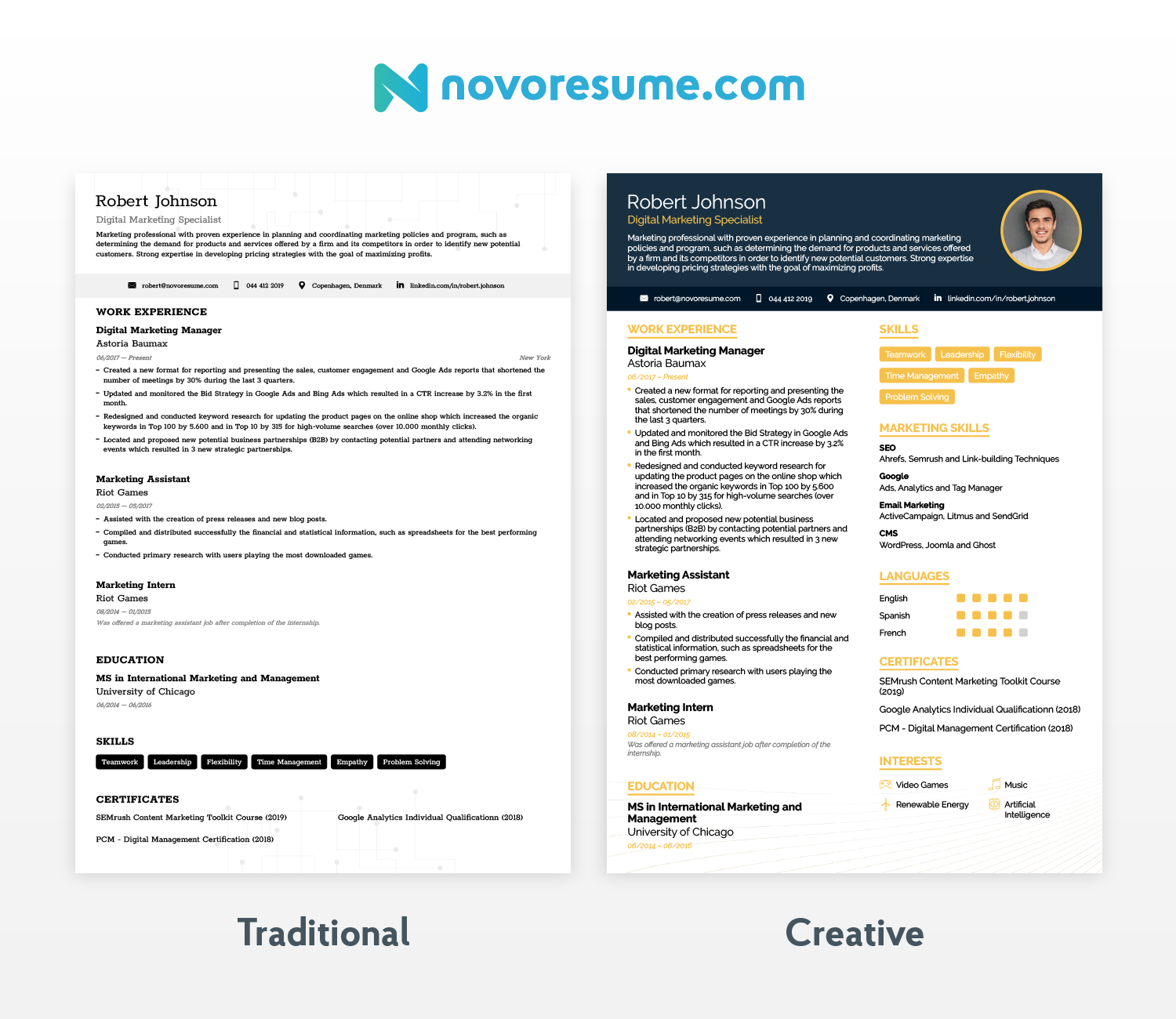
If you’re pursuing a career in a more traditional industry - legal, banking, finance, etc., you might want to stick to the first one.
If you’re applying to a tech startup though, where imagination and innovation are valued within the company value, you can go for something creative.
How to Add Your Contact Information in a CV (The Right Way)

Your contact information is arguably the most important part of your CV. After all, even if you get everything right, it’s not going to matter much if they can’t contact you.
Make sure you triple-check everything in your contact information, word for word, and that it’s up to date.
- First name, Last name - the generally preferred format is Name, Last name.
- Phone number - make sure to include your country code if applying outside your country.
- Email address - your email should be professional, ideally along the lines of [name][last name]@email.com
- Title - your professional title, either your desired job or the one you’re applying for word for word.
- Location - are you located in the area? Relocating there in a month or two? Or maybe you’re looking for a relocation sponsor?
Aside from the basic contact information, you also might want to consider putting your social media handles - as long as they’re relevant.
For every other social media channel, consider how they reflect your work. For example:
- LinkedIn - many people ask for a LinkedIn link when applying for a job. As long as your LinkedIn profile is complete and optimized (as it should), feel free to include your LinkedIn URL in your CV.
- Twitter - in very specific cases (e.g. marketing or journalism position), you could include your Twitter profile if you’re active, have a decent amount of followers and a writing style relevant to the position.
- Quora - do you have a lot of authority on a specific topic in your field with a decent amount of followers? This can convince the HR manager that you’re really the best expert they can hire.
- Stack Overflow / Github - only for developers, coders, and computer scientists.
- Medium - only for freelance writers, bloggers, and so on.
- Anything else - got a relevant personal website, blog, or a YouTube channel? Use your discretion if it’s relevant.
All clear? Now let’s discuss how to stand out within your CV summary or objective.
How to Grab the HR Manager’s Attention With a CV Summary or Objective
Your CV summary or objective is your attempt at an important first impression. Make sure the language you use is clear, and the HR manager doesn’t have to read it a few times to understand it - because they won’t.
Does it pass the 6-second test?
Your CV summary or objective is your attempt at an elevator pitch with 2-3 sentences.
As a rule of thumb, if you have more than 2 years of work experience - go for a CV summary.
If not - go for a CV objective.
Let’s break that down.
- Jobs and years of work experience.
- Relevant achievements and responsibilities.
- What you look for, your goal.
With that said, your CV summary might look something like this:

To make your summary memorable, make sure you mention how your previous experience will be beneficial to the current you’re applying for. You should also include the following information:
- What can you do for them? How can you help?
- How will your previous experience help fit in the company’s current environment?
- How can you help them grow while maintaining personal goals?
Now, how to write a CV objective?
Just like your CV summary, your objective should be 2-3 sentences at most. But instead of describing your work experience, it should focus more on your motivation for applying for the specific job.
If, for example, you’re a recent college graduate with not a lot of experience under your belt, you might want to opt-in for the CV objective instead. This will explain your motivations as well as what you hope to gain from the position.
To create a killer CV objective, you might want to include:
- Skills, education, and certificate relevant to the job title.
- Type of responsibilities to help you will help out with successfully.
- How you can apply what you’ve learned so far.
Your CV objective might look something like this:
“Hard-working recent college graduate with a B.A. in graphic design from NY State University. Seeking new opportunities, with 3+ years of practical experience with Adobe Illustrator, Photoshop, creating and designing UX / UI. Looking to grow as a designer, as well as perfect my art at XYZ Studio.”
In a nutshell, summarize the goal of your resume and communicate your motivation for getting into the field.
How to Show Off Your Work Experience (And Stand Out)
Alright, if you’ve made it this far, now it’s time to really show off and sell yourself.
Your work experience is where you get to brag a little, assuming it’s justified and accurate, of course.
This is the MAIN section of your CV and where most HR recruiters jump to when looking at your CV.
It’s also the deciding factor of whether you’ll get hired or not - no pressure.
So, to perfect your work experience section, the standard format is as follows:
- Job title/position.
- Company name, location, description.
- Achievements and responsibilities.
- Date employed.
While it may sound straightforward, it can be fairly tricky to sum up your work experience in just a few bullet points.
Many people simply list their responsibilities next to the position.
While this is OK, you should always try to write achievements and accomplishments instead.
The HR manager most likely already knows what a business development manager or a sales manager does. You don’t want to seem like the average professional - you want to present yourself as an A-player, someone that shakes the company up (in a good way).
So, you might want to make it clear how you took the company from point A to point B. Here is how a well-written CV work experience looks like:
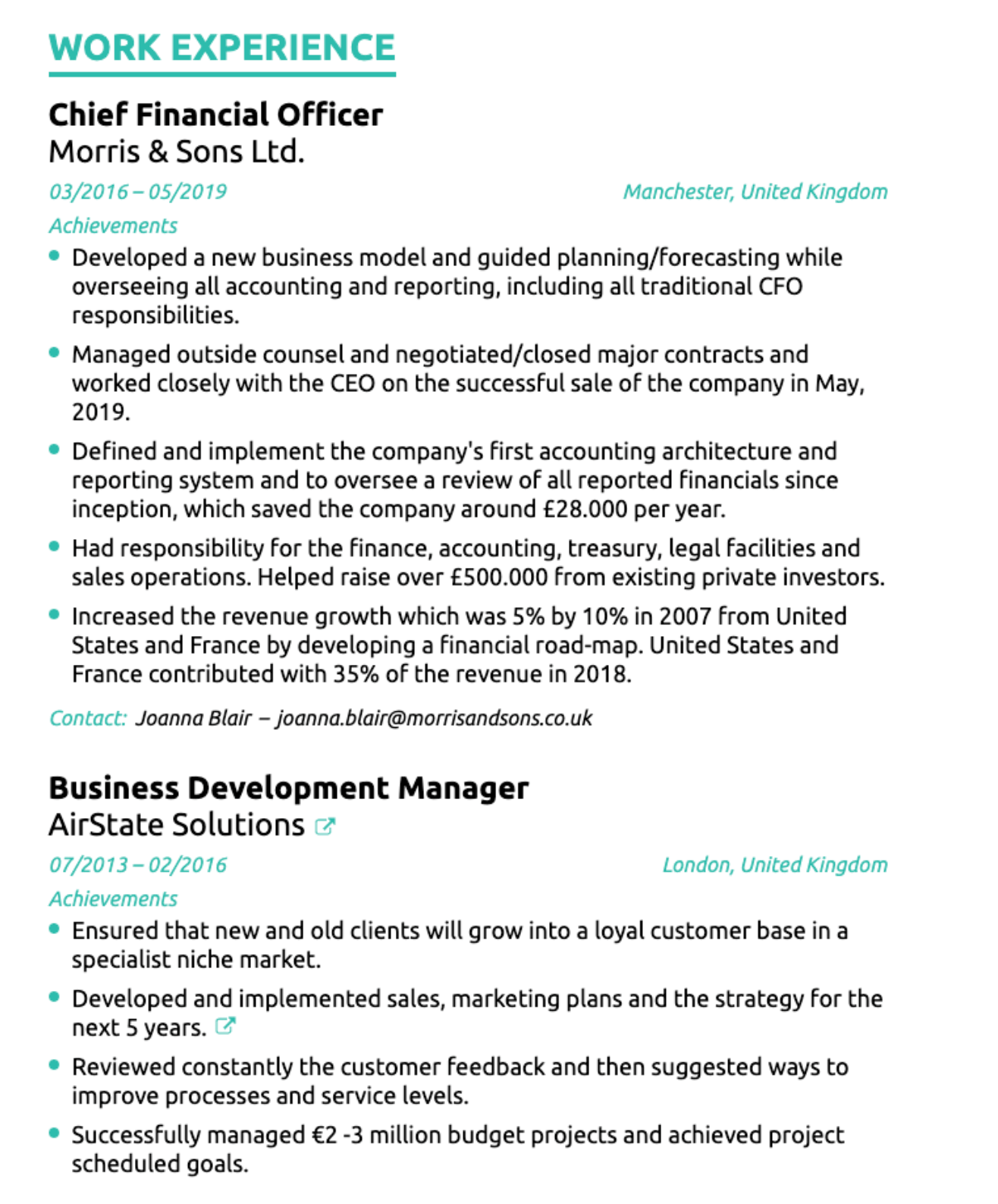
As you can see, the work experience order is in reverse-chronological order, with the most recent job first. And in terms of the activities, the details are backed up by numbers and percentages.
It’s much more actionable as well and gives the hiring manager an idea of how you can benefit their company.
If you want to assure them you’re going to be a right fit, find what skills and responsibilities are listed in the job and, make sure you place them in the relevant sections of your CV. Look for what skills and responsibilities they’re looking for in the job ad, and tailor your CV accordingly.
Look for some soft skills and optional requirements that are listed in the job ad, and if they apply to you - feel free to include those specific keywords.
A bad work experience example would be something like:
- “Increased customer support satisfaction closing rate”
- “Generated new leads by cold calling and managed existing clients”
- “Wrote social media content and increased engagement and reach.”
With that said, in some fields (e.g. cashier in a supermarket), you don't have a lot of wiggle room in terms of achievements. In that case, you can simply stick to your daily responsibilities.
Skills Section on Your CV
Consider your hard and soft skills.
Hard skills are technical skills that can be measured and are directly related to your tasks.
Soft skills, meanwhile, are learned skills such as your personal attributes (e.g. leadership, communication, etc.).
Usually, job qualifications already include what they’re looking for in terms of skills. For example:
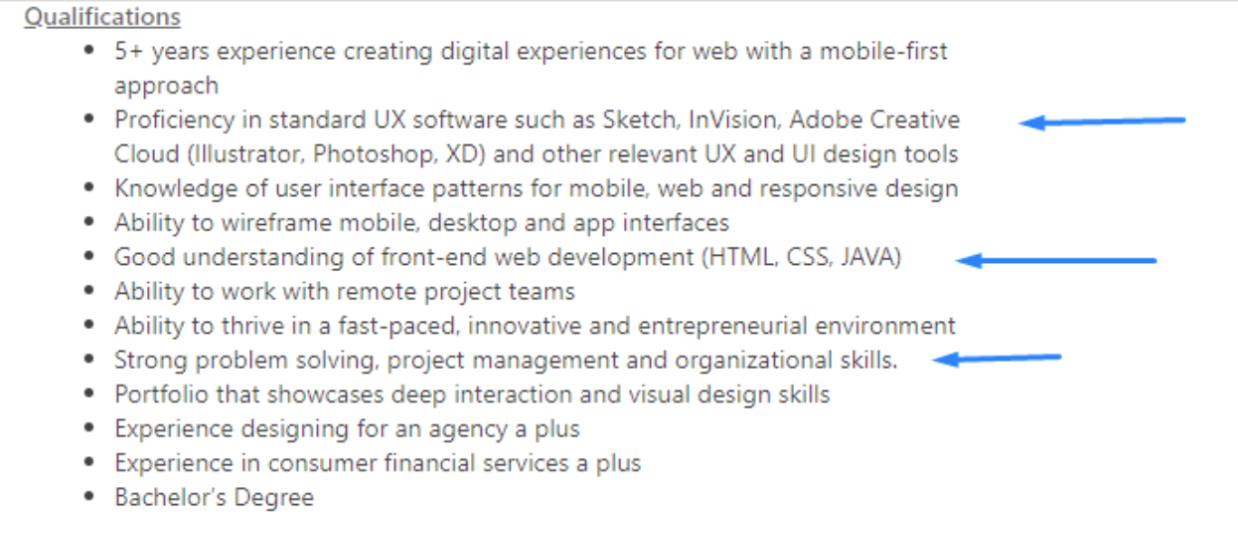
As you can see, the skills required for this position include a mix of hard as well as soft skills.
Now, all you’d have to do is tailor your CV to the qualifications list.
For the hard skills that are backed up by your work experience, you can measure them or give yourself an honest rating, like so:
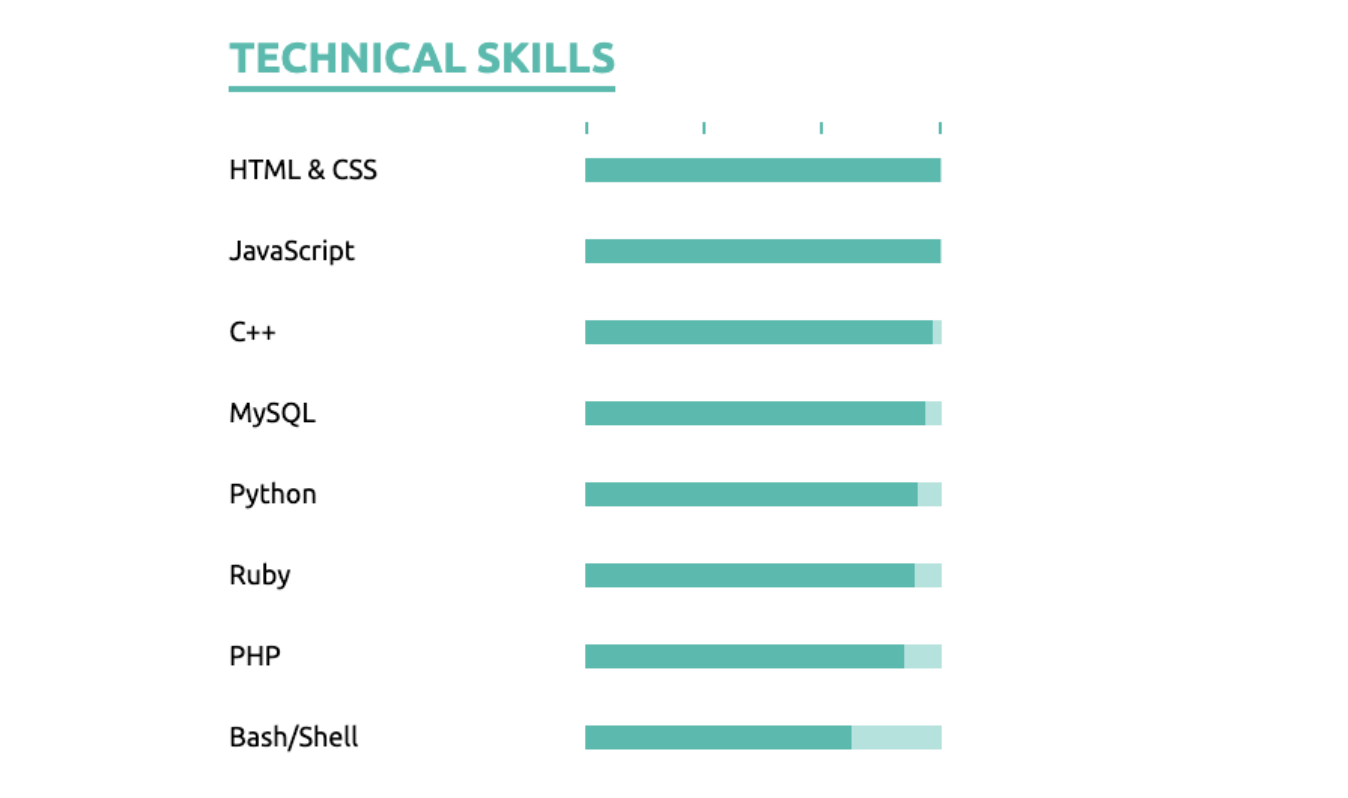
To write a good skills section though, you also need to include your soft skills, like so:
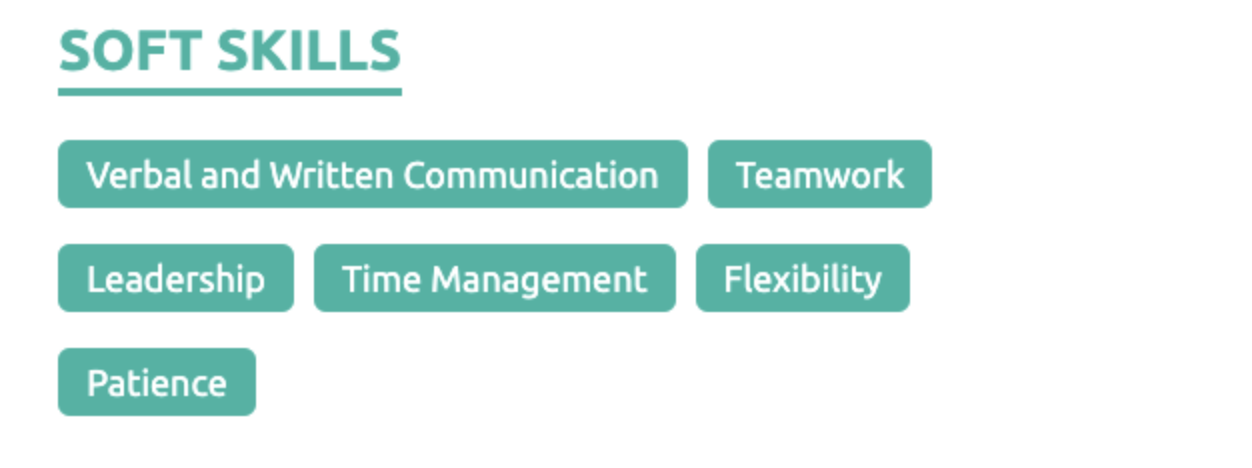
There’s one other type of skill section that you can list within your CV, and that is universal skills. This includes skills that are fit in the description or requirements of most career fields - such as MS office, teamwork, analytical thinking, and more.
No matter what job you’re applying for, these skills will typically come in handy at some point.
Education Section on Your CV
Another important part is the education section of your CV.
- Program name - e.g. BA in business administration.
- University name - e.g. NY State University.
- Year attended - e.g. 08/2008 - 06/2012
- (Optional) GPA - e.g. 3.9 GPA
- (Optional) Honors - e.g. Cum Laude, Magna Cum Laude, Summa Cum Laude
- (Optional) Academic achievements - e.g. relevant papers you’ve written, courses you’ve excelled in.
- (Optional) Minor - e.g. Minor in psychology
On paper, your education section might look something like this:
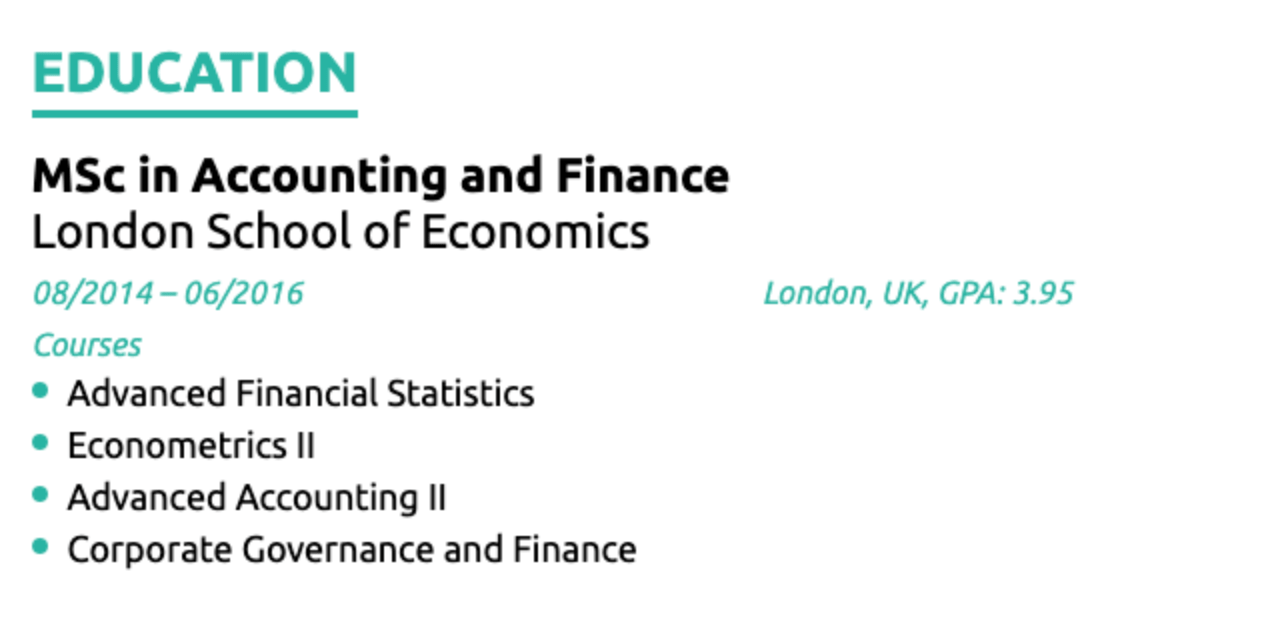
When perfecting your education section, here are a couple of things you should keep in mind:
- If you don’t have any work experience, mention your education section first.
- If you have a university degree, don’t mention your high school at all.
- Mention your GPA only if it’s notable (anything between 3.5-4.0).
The above is a list of categories you’re likely to find on pretty much every CV ever. What goes into them is what matters though. They’re essential and in most cases, they decide whether you’re the right fit or not.
Now, what about the optional sections of your CV?
They can help you show off a bit of your personality. Depending on the job and the person reviewing your CV - this might help you out and tip the scales in your favor.
Here are some of the optional sections that might go on your CV:
Other Sections for CV
The following sections can help you stand out, depending on the company culture and how unique your hobbies are.
For the most part, you’re going to be using your discretion to decide if they’re relevant or not within the bigger picture of your CV. These sections might include:
Certificate and Awards
Include any certifications you have if they’re relevant to the position here.
If you’re a Facebook Blueprint certified marketer - feel free to include that.
If you don’t have a lot of work experience, you can also include any relevant courses or online certifications that show you’ve taken the first step and to show you’re interested (e.g. HubSpot marketing training, Google Certifications, or just about anything you took on Coursera).
Languages
Most companies are international nowadays, being bilingual is a great way to stand out and have a competitive advantage.
Even if language skills aren’t necessary to the position, they might come in handy at some point.
When listing your languages, you can categorize them between:
- Native
- Fluent
- Proficient
- Intermediate
- Basic
It goes without saying that you should be honest here and don’t lie on your language skills - it’s just not worth it.
Hobbies and interest
This is where you get to reveal a bit of your personality. You can mention something unique here if you want to stand out.
What interests you? What makes you unique as an individual?
To go the extra mile and show your general discipline and commitment, you can include personal achievements within your hobbies.
For example, if you’ve run a marathon (something you should be proud of), you can include that in your hobbies. And who knows, you might have something in common with the HR manager as well.
Personal projects
Side projects show your passion and dedication. They can help you make up for any lack of experience in a certain field, or display your passion for the job.
If you’re going to include optional sections within your CV, make sure they’re relevant and paint you in a positive light - either professionally or through your personality.
Top 3 CV Examples
If you apply everything we’ve learned so far, you should have a very well-rounded and detailed CV. Congrats, you’re already prepared to take on the world!
If you’ve never seen what a good CV looks like, though, it might seem a bit hard to get started with yours.
These 3 effective CV examples should give you the inspiration you need to get started:
Graduate CV Example
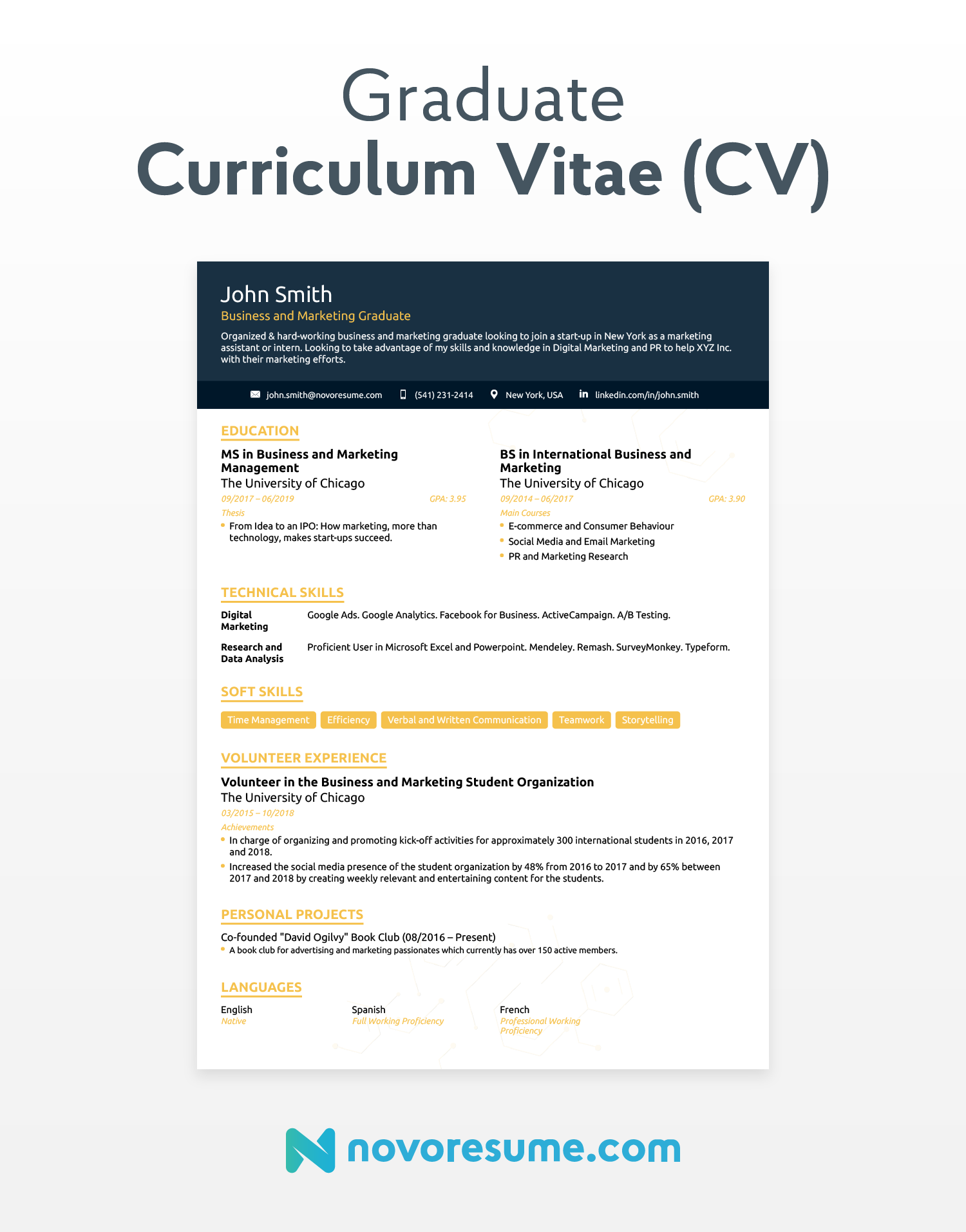
Academic CV Example
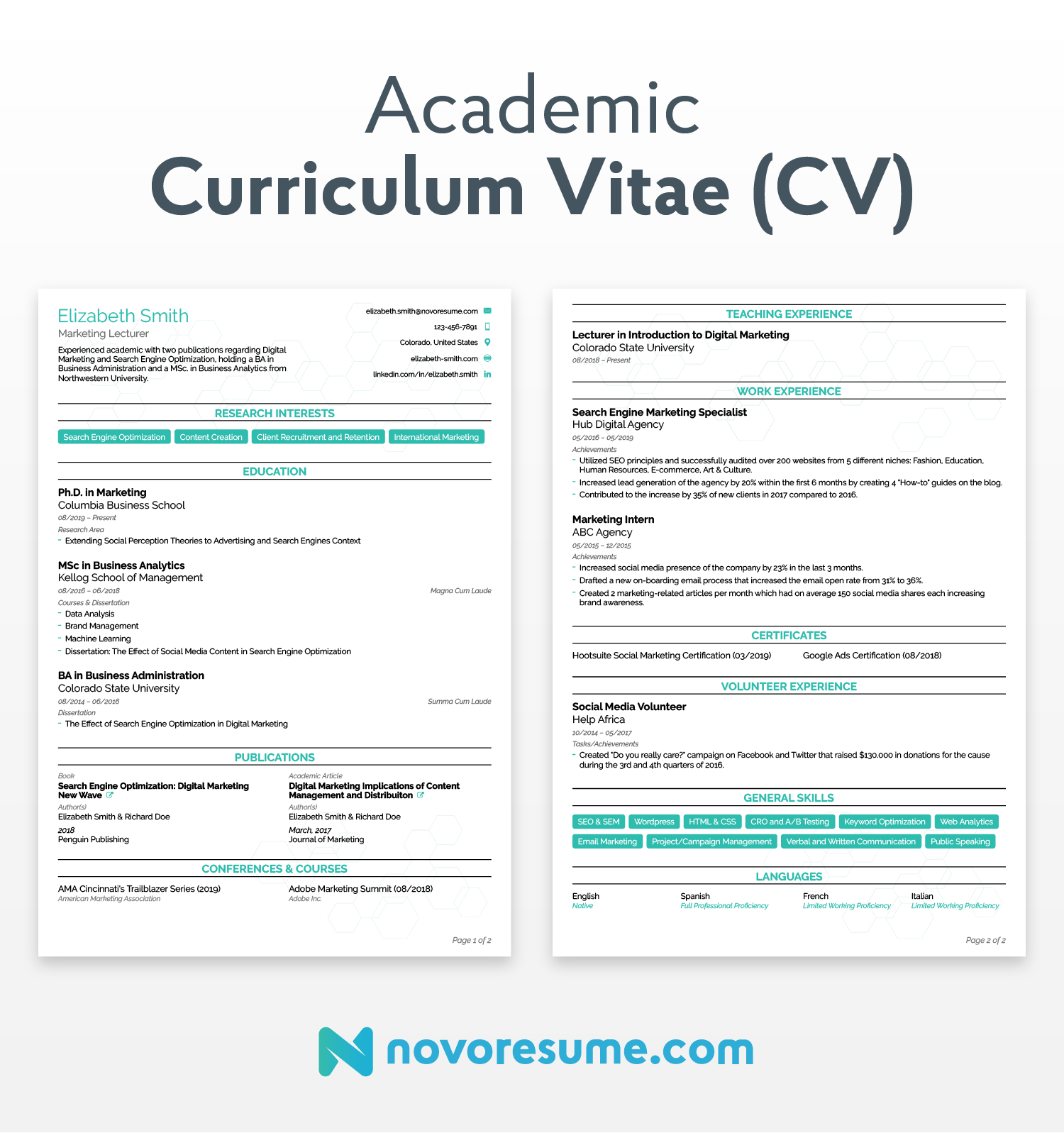
Executive CV Example
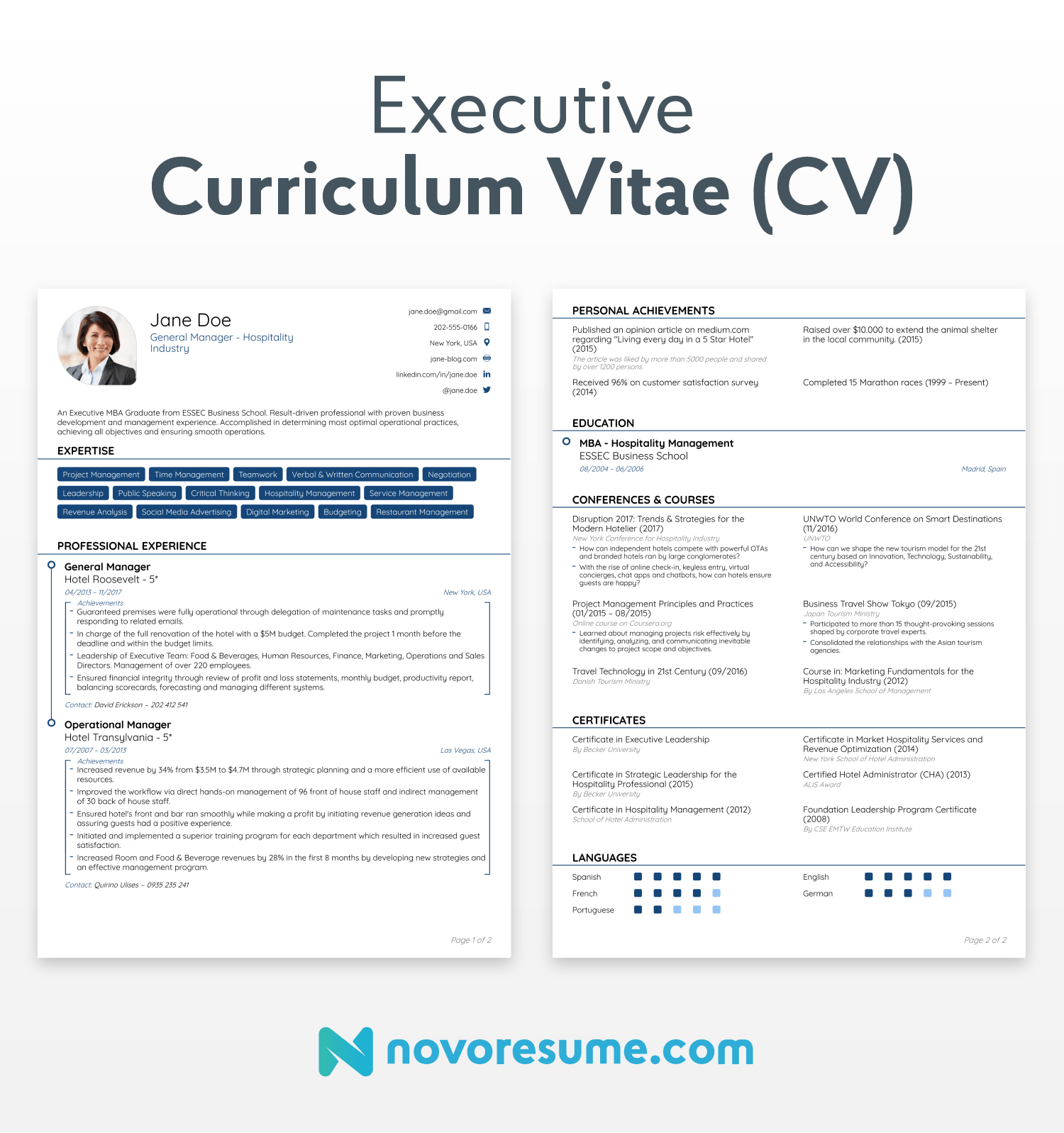
Looking for additional resume examples? Check out some of our other listicles:
Next Steps in Your Job Search - Cover Letter & Interview
With your CV ready in your hand, you now need to prepare for the next steps in your job search: writing a cover letter and acing the interview.
After all, a CV is only the first part of the job search process. And no matter how good it is, to really land your dream job, your cover letter and interview skills need to be on par as well.
Now, cover the basics of each (and make sure you land that job!)
How to Make a Cover Letter
Essentially, a cover letter is a one-page document that you submit as part of your job application. Its purpose is to introduce you and briefly summarize your professional background in about 250-400 words.
Not sure what to include in your cover letter?
It’s fairly simple, actually, once you know its purpose.
Think of it this way: Your cover letter is a direct message to the hiring manager. In it, you get to explain why you’re suitable for the application.
Keep in mind, though, that a cover letter is a supplement to your resume, not a replacement.
Make sure your cover letter is not repeating information from your CV as well.
- Introduction - give a brief intro on your work experience, and mention why you're interested in that company specifically. You can also mention some of your 1-2 top professional achievements to leave a first good impression.
- Qualifications - identify the top 3 requirements for the job ad, and then explain how you'd fulfill each one.
- Recap - thank the reader for reading your letter and end with a call-to-action. For example, “If you’d like to know more about my experience with Project XYZ, I’d love to chat!”
Here’s what an effective cover letter looks like in practice:
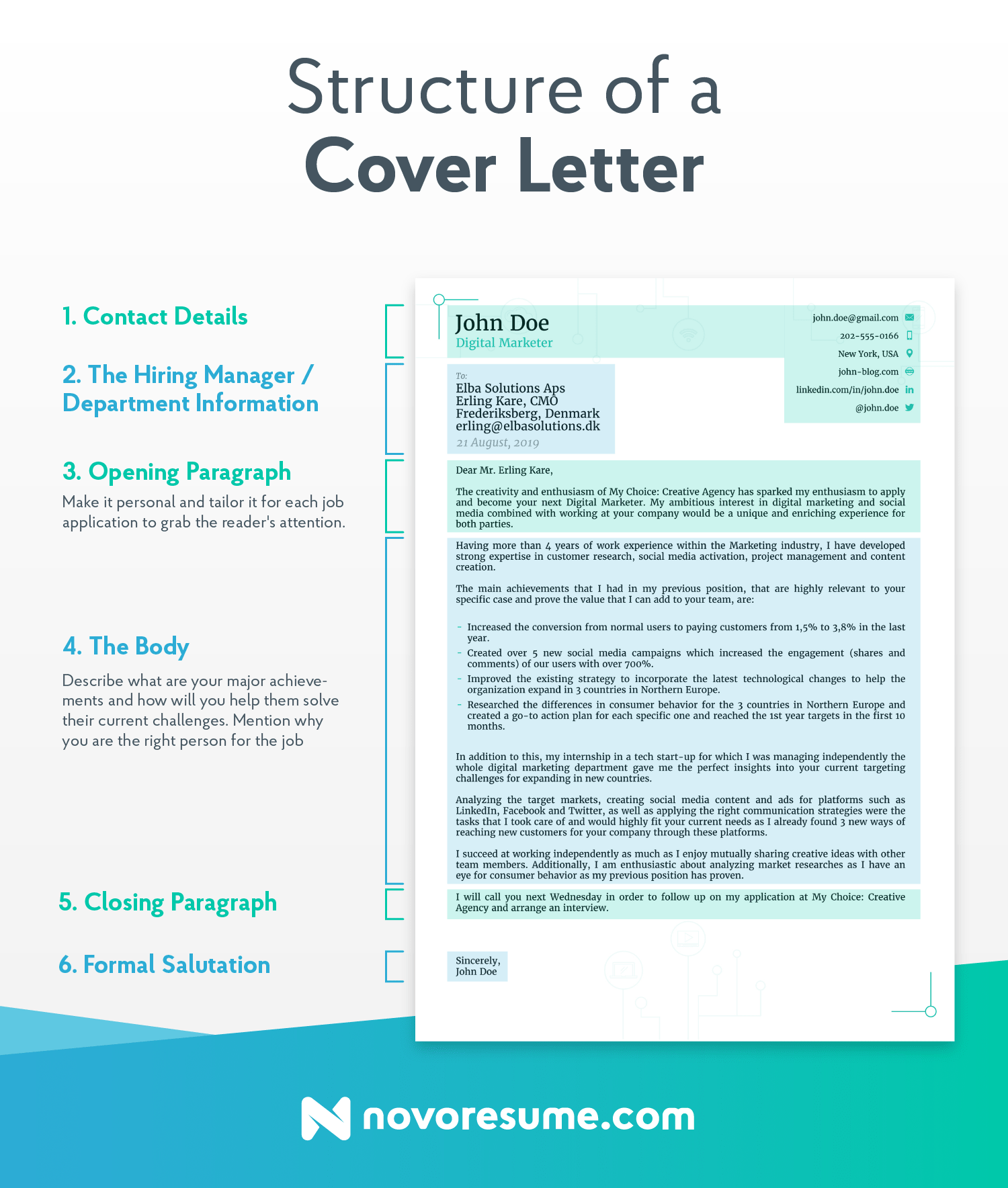
How to Ace Your Interview
If you’ve made it this far - congratulations are in order. But you can’t celebrate just yet. The final gatekeeper standing between you and your dream job is the interview process.
If you hate the interview part, you’re not the only one. After all, explaining your whole work experience while someone is judging you over it is not our idea of fun either.
But there is a silver lining here. Most interviewers ask the same questions. All you have to do is prepare and do your research beforehand.
Common interview questions may include:
- Why would you like to work here?
- Why should we choose you?
- Tell me about yourself.
- Where do you see yourself in 5 years?
Sounds cliche?
That may be, but they’re looking to get to know you as an employee as well as what your personality is like to see if you’d fit within their work culture.
So, it’s a good idea to take the time and prepare in advance.
If you want to learn more - check out our Job Interview Questions and Answers guide.
Key Takeaways
At this point, you should feel pretty confident about the whole job-search thing.
The whole process might seem a bit intimidating at first, but now that we broke it down into bite-sized pieces, it should be much easier to understand.
To recap:
- The essential information on your CV includes: contact information, CV summary or objective, work experience, education, and skills.
- Optional sections may include: certifications and awards, languages, hobbies, interests, and any relevant social media channels.
- Make sure your work experience and results are backed up data or some form of measurable change.
- Lastly, make sure your CV is tailored to the specific job, your cover letter is relevant and doesn’t repeat your CV, and that you’re prepared for some of the obvious interview questions.
Getting the right job is just a single step in your career. There’s still a lot to learn, young padawan.
Follow our career blog to stay up-to-date with the latest career advice!
Suggested reading:


